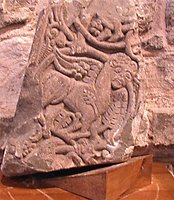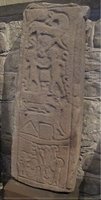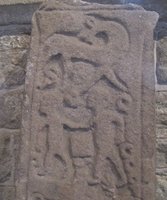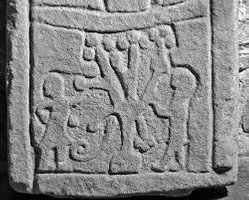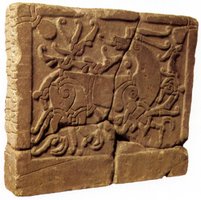Dacre church - two intruiging stone cross fragments.
The lion and the naughty snake..
In this blog we move from the outside graveyard of Dacre's church to the inside..
One might easily oversee gems within churches in Cumbria. Unless one had done his research and knows where to look..
There are two reminders of the Viking period within the church. These are two beautifully carved cross shafts, one dating from the 9th century, the other, larger, dating from the 10th or 11th century. The smaller, older cross fragment is carved on four sides. The best preserved of the carvings represents a winged lion with serpent head.
The larger stone was discovered amongst the rubble when the east wall was being restored in 1875 and is thought to be a thousand years old.
The larger cross is a fascinating piece of 10th century art. It stands, propped against the wall of the church, exposing a narrow set of panels, each carved with intriguing characters. The topmost panel shows a beast above two figures clasping hands. Beneath the hands is a small table. It is suggested that the figures are a reference to the Biblical story of Abraham and Isaac. Below this panel is one showing a stag with a hound on its back. This hunting theme was a common motif in the Viking period, and may also have had religious intent. The lowest panel is quite beautifully sharp and clear. It shows a large tree, with two figures beneath it. One figure is reaching up to the tree. This has been suggested as a depiction of Adam and Eve in the Garden of Eden. Whilst Adam is without clothes, Eve wears a very fetching skirt! Who wouldn't approach her..
As one sees, running late in October, the light was far from ideal, when I took these photos, so beneath one the right of my photo I have attached photos of someone who was more lucky in making them..
On the left the detail of the stone with Adam and Eve in the Garden of Eden. See the Ringerike style spiral form of the snake approaching the skirt of Eve and also the Ringerike style depiction of the branches with leaves. Compare with the stone in Ringerike style found in churchyard of St. Paul’s Cathedral, London.. The depection on the stone with Adam and Eve may be of a cruder Anglo-Scandinavian form, but it is still recognisable as so.
Link to blog November 7th 2015
In the forthcoming blog I take you to a visit to Kendal Museum in Kendal, Cumbria with among other interesting things, an intruiging female who is pointing out quite explicitally...
References:
Well. I could have been with these stones until after dark, but as my wife wanted to travel on.. well.. I see you again, some day, hogback stones from Gosforth. And if you happen to be there one day, do not forget that monument on the outside...
Further on with the Cumbrian hogbacktour !
In - yes, luckily again in - St. Peter's church in Heysham, there is a truly beautiful hogback stone. The guide told us, it had been studyied by Thor Ewing, a writer, in 2000. in 'Understanding the Heysham hogback' A tenth century sculpted stone monument and its context (link), Thor Ewing tells in detail what he dicovered on the both sides of this hogback stone.
Just being brought in the church as late as the 1970's accompanied with some protest here and there among the church visitors, considered as being a token of old paganism, it had been remarkably nice preserved, and a lot of detail can be seen, still. Truly worthwile a visit.
I had a small debate with the guide in the church if the - zoomorphic, in my opinion - faces on the sides were lions (or hippo's). The guide doubted if the vikings could have known about lions. Well I guess so, concerning the runes on the Ancient Greek lion statue at the Arsenal, Venice. For example. Vikings did travel south..
But when he told me he was doubting the vikings 'discovered' (as the native inhabitants were of course, in the first place) America before Columbus, I decided to rest my case..
One has to know when to start and to end a conversation ..
Just discovered the book in a bookstore written by Geoff Holder - The guide to the mysterious Lake District, I knew there had to be another hogback stone in Lowther, St. Micheal's Church. With a promising image described in the text of 'a naval and a land-based force of shield-bearing vikings above a fish and what might be a coiled sea serpent. On the reverse is a row of female figures with snakes, possibly a representation of the hideous hag Hel'. Wow. If that did not sound as a true pagan promised land ..
Not complaing too much after all we have seen, this visit was the dissapointing one of them all. But if you wife states 'I am happy to have seen them' and I am answering 'Measuring is knowing' and the even more obligate verb 'handling 'if we did not see it at all, we wouldn't have known anything at all of how they were looking' the glass was again half full, at the last day of our journey..
The hogback stone appeared to be just being tolerated within the entrance segment part of the church. As something you never use anymore but you do not throw away - entirely. That sort of feeling emerged when seeing this hogback asylum seekers.. Bed, bath and bread, ás we say in Dutch, but no luxury at all and standing on some outcuts of wood, you would balance the table with at home..
Come on, St. Micheal's Church.. care a bit more of your 'children' !
This hogback stone was moved in the church in 1907. Hogback stones layed partially buried in the churchyard before it was dug up and moved into the church.
The promising depiction of a longship - as certainly can be seen after some studying - see http://vikingminds.co.uk/pages/longship
we have missed !
The stone itself is (157 x 50 x 30 cm) and very worn.
The hogback stones in Cumbria - very diverse in quality, but everyone worth a visit ! Especially on a gloomy day in late October ...
The churches to visit - see photos of resp. St. Andrew's church in Penrith, St. Mary's church in Gosforth, St. Peter's church in Heysham and St. Micheal's church in Lowther.
Did I miss out on another one in Cumbria ? Let me know !
In a next blog I will take you to four - still remaining utterly mysterious- statues 'guarding' the graveyard of St. Andrew's church in Dacre..
For the last blog of October 9th see this link.
References: (as always, links to where the books can be ordered are attached).
Edwards, B.J.N. Vikings in North West England - The artifacts (1998);
Emery, Gordon, CURIOUS CUMBRIA, The Lake District & Beyond: A celebration of Cumbria (2023)
Ewing, T. 'Understanding the Heysham hogback' A tenth century sculpted stone monument and its context ;
Hall, R. Viking Age archaeology in Britain and Ireland (first printed 1990, reprinted with amendments in 1995);
Holder, G. The guide to the mysterious Lake District (2009)
possibly also (as there within the part of Cumbria dealing with Carlisle, the Eden Valley, Barrow-in-Furness, Whitehaven and the west coast is being dealed with)
Holder, G. Paranormal Cumbria (2010)
http://vikingminds.co.uk/pages/longship
